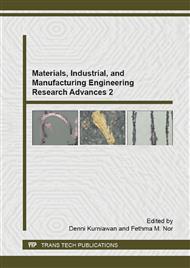p.89
p.94
p.100
p.106
p.111
p.116
p.121
p.126
p.131
Morphological Effect of Composite Coated SUS430 Steel during Thermal Oxidation Process
Abstract:
High temperature behaviour is important characteristic to be evaluated for internconnect materials in solid oxide fuel cell (SOFC) application. The present works concern in evaluating the morphological effect of composite coated SUS430, prospective material for SOFC application, on the high temperature behavior of the composite. Thermal spray method has been conducted as the major coating processes whereas thermal oxidation and sol gel coating is the addition coating method performed in the present works. Through variation of coating processes in the present works, different morphology of composite coated SUS430 alloy were obtained. Scanning electron microscope (SEM) characterizations have been performed in order to evaluate the morphological aspect of the coated samples before and after thermal oxidation process. In addition, X-ray diffraction characterization has been performed in order to identified the existing phase before and after thermal oxidation. From both characterization results, it was obtained that particle size of the composite layer influences the compactness and porous characteristic of the layer and in turn influences the oxidation characteristic of the layer during high temperature services.
Info:
Periodical:
Pages:
111-115
Citation:
Online since:
October 2015
Authors:
Price:
Сopyright:
© 2015 Trans Tech Publications Ltd. All Rights Reserved
Share:
Citation:


